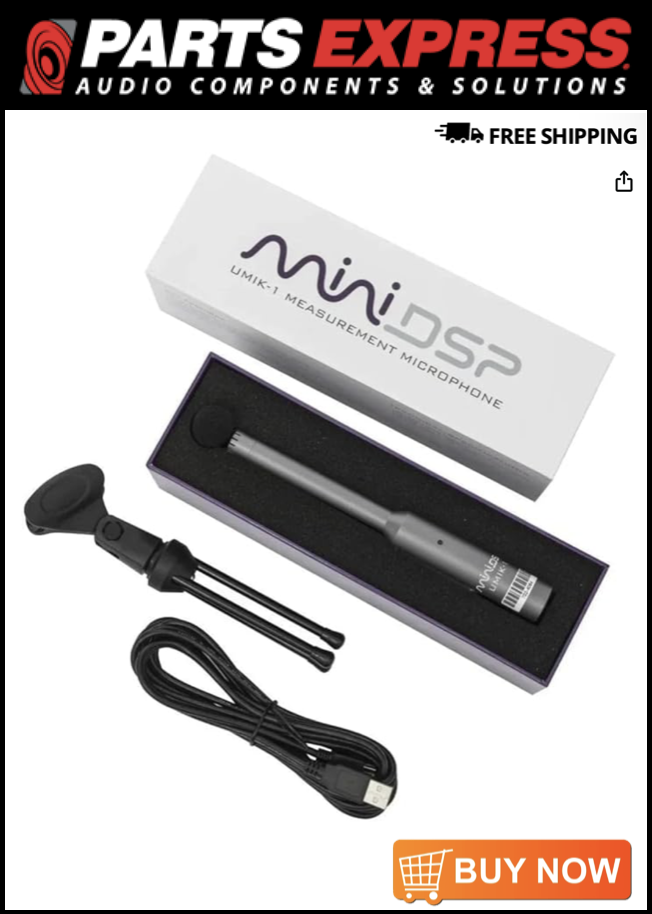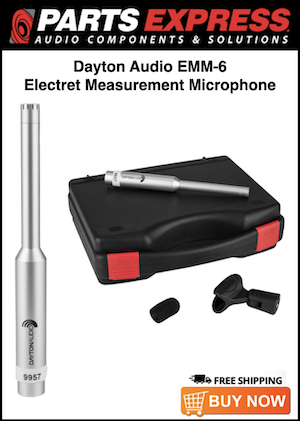-
AUDIO VIDEO PROCESSING, SETUP & ENVIRONMENTOfficial REW (Room EQ Wizard) Support Forum Audiolense User Forum Calibration Equipment Auto-EQ Platforms / Immersive Audio Codecs Video Display Technologies / Calibration AV System Setup and Support Listening Room / Home Theater Build Projects Room Acoustics and Treatments AV Showcase Movies / Music / TV / Streaming
-
AUDIO VIDEO DISCUSSION / EQUIPMENTHome Theater / Audio and Video - Misc Topics AV Equipment Advice and Pricing Awesome Deals and Budget AV Equipment AV Receivers / Processors / Amps UHD / Blu-ray / CD Players / Streaming Devices Two Channel Hi-Fi Equipment DIY Audio Projects Computer Systems - HTPC / Gaming HD and UHD Flat Screen Displays Projectors and Projection Screens AV Accessories Buy - Sell - Trade
You are using an out of date browser. It may not display this or other websites correctly.
You should upgrade or use an alternative browser.
You should upgrade or use an alternative browser.
ECM8000 calibration file
-
 Thread starter
Chesco
Thread starter
Chesco
- Start date
John Mulcahy
REW Author
- Joined
- Apr 3, 2017
- Posts
- 8,033
There are lots of them, such as the first hit for "ecm8000 calibration file", but they are most likely worse than no file at all. The mics vary a lot.
Matthew J Poes
AV Addict
- Joined
- Oct 18, 2017
- Posts
- 1,903
Thanx for your reply. Is there any way to make a calibration file for my specific one?
Rent a known accurate mic with a NIST certification and serialized response file. Create a compensation file for the rented mic. Setup a speaker in a room. Place the mic one meter from the speaker and measure a handful of times. Replace the mic with your mic. Be certain the mic is in exactly the same spot to the mm. Repeat. The difference between the two is your correction file.
John Mulcahy
REW Author
- Joined
- Apr 3, 2017
- Posts
- 8,033
You can also send your mic off for calibration, Cross Spectrum offer that.
Rent a known accurate mic with a NIST certification and serialized response file. Create a compensation file for the rented mic. Setup a speaker in a room. Place the mic one meter from the speaker and measure a handful of times. Replace the mic with your mic. Be certain the mic is in exactly the same spot to the mm. Repeat. The difference between the two is your correction file.
This sounds simple enough....famous last words.
I'm going to give it a try.
I've got a UMIK1 with a correction file form cross spectrum labs. I'll consider it my reference.
I've got a simple USB mic from a Paradigm room EQ system (Anthem Room Correction) that doesn't have a correction file. I want to create a correction file for it.
Once I've got a graph for each mic in REW, how do I generate that "difference" file, and how do I save it in a format that will let me import it into REW as a correction file for using the "new" mic later?
G29
Member
- Joined
- Jun 20, 2019
- Posts
- 95
More
- Main Amp
- Quad Stereo Amp
- DAC
- OKTO Research DAC8
- Computer Audio
- i7-6700, Debian 12, custom VST3 feeding CamillaDSP, REW, RePhase, custom Driver Level DRC-FIR with 128-bit internal (i)FFTs, 8 - 64-bit 256K tap FIRs
- Front Speakers
- Heavily modified Magenpan 20.1 with FIR XOs
- Subwoofers
- DIY OB/Dipole
- Other Equipment
- Full Mark Levinson Stack
... I'm going to give it a try.
I've got a UMIK1 with a correction file form cross spectrum labs. I'll consider it my reference....
Once I've got a graph for each mic in REW, how do I generate that "difference" file, and how do I save it in a format that will let me import it into REW as a correction file for using the "new" mic later?
I just tried it using a Cross Spectrum Labs calibrated UMIK-1's measurement (GREEN) as the baseline and an un-calibrated ECM8000 measurement(RED). The derived ECM8000 calibration SPL measurement(BLUE) tracks pretty close to the GREEN baseline, but the phase is a bit off at the ends.
- I used the "File/Export Measurement as Text" option to do a text dump of the calibrated and un-calibrated files.
- I edited the text files to remove the file and column header information leaving only the 3 measurement numeric columns (frequency, SPL and phase).
- I then loaded both files into a spreadsheet in different worksheets and subtracted the calibrated SPL column from the un-calibrated SPL calibrated column creating a new delta column in a 3rd worksheet.
- I then output 2 columns as a text file (65508 lines), first column being the frequency and the second column being the SPL delta from the 3rd worksheet.
- I added an extra 0 to the last 2 lines (3rd column) as what is in the CS calibration files. Don't know if this is necessary or not.
9.887695 -7.306065
10.253912 -7.313499
10.620129 -7.339039
10.986345 -7.437733
11.352562 -7.71809
11.718778 -8.160614
12.084994 -8.515365
...
...
...
23996.70313 -31.04581
23997.07031 -31.047973
23997.4375 -31.050133
23997.80469 -31.052304
23998.16797 -31.054439
23998.53516 -31.056595
23998.90234 -31.058747
23999.26953 -31.060902 0
23999.63281 -31.063012 0
Here are the before and after results.
Hope this helps and if anyone has a better way to do it, or corrections, please advise.
Wow you got farther than I managed to.
I couldn’t make heads or tails of the file data and no one else seemed to understand it either when I posted it.
But you have solved it.
That calibration file’s results look excellent.
You have inspired me to try again.
Thanks for sharing!
.
I couldn’t make heads or tails of the file data and no one else seemed to understand it either when I posted it.
But you have solved it.
That calibration file’s results look excellent.
You have inspired me to try again.
Thanks for sharing!
I just tried it using a Cross Spectrum Labs calibrated UMIK-1's measurement (GREEN) as the baseline and an un-calibrated ECM8000 measurement(RED). The derived ECM8000 calibration SPL measurement(BLUE) tracks pretty close to the GREEN baseline, but the phase is a bit off at the ends.
Example Delta Text File:
- I used the "File/Export Measurement as Text" option to do a text dump of the calibrated and un-calibrated files.
- I edited the text files to remove the file and column header information leaving only the 3 measurement numeric columns (frequency, SPL and phase).
- I then loaded both files into a spreadsheet in different worksheets and subtracted the calibrated SPL column from the un-calibrated SPL calibrated column creating a new delta column in a 3rd worksheet.
- I then output 2 columns as a text file (65508 lines), first column being the frequency and the second column being the SPL delta from the 3rd worksheet.
- I added an extra 0 to the last 2 lines (3rd column) as what is in the CS calibration files. Don't know if this is necessary or not.
9.887695 -7.306065
10.253912 -7.313499
10.620129 -7.339039
10.986345 -7.437733
11.352562 -7.71809
11.718778 -8.160614
12.084994 -8.515365
...
...
...
23996.70313 -31.04581
23997.07031 -31.047973
23997.4375 -31.050133
23997.80469 -31.052304
23998.16797 -31.054439
23998.53516 -31.056595
23998.90234 -31.058747
23999.26953 -31.060902 0
23999.63281 -31.063012 0
Here are the before and after results.
Hope this helps and if anyone has a better way to do it, or corrections, please advise.
View attachment 38454
.
G29
Member
- Joined
- Jun 20, 2019
- Posts
- 95
More
- Main Amp
- Quad Stereo Amp
- DAC
- OKTO Research DAC8
- Computer Audio
- i7-6700, Debian 12, custom VST3 feeding CamillaDSP, REW, RePhase, custom Driver Level DRC-FIR with 128-bit internal (i)FFTs, 8 - 64-bit 256K tap FIRs
- Front Speakers
- Heavily modified Magenpan 20.1 with FIR XOs
- Subwoofers
- DIY OB/Dipole
- Other Equipment
- Full Mark Levinson Stack
Wow you got farther than I managed to.
I couldn’t make heads or tails of the file data and no one else seemed to understand it either when I posted it.
But you have solved it.
That calibration file’s results look excellent.
You have inspired me to try again.
Thanks for sharing!
I am going to redo it with better measurements and try exporting both files with no smoothing enabled to see if it gets any better. It will tide me over until I can get it properly calibrated. Good luck.
simplex
Member
More
- Preamp, Processor or Receiver
- Rotel RC-1570
- Main Amp
- Quad 303 mod.
- Computer Audio
- Daphile @x86-Mini-PC with BruteFIR filters applied
- Universal / Blu-ray / CD Player
- Yamaha BD-A1020 (mostly inactive, Daphile rules!)
- Streaming Equipment
- audio cables custom made by myself
- Front Speakers
- Tannoy D500 mod.
- Other Equipment
- Steinberg UR12, Behringer ECM8000
I also have a ECM8000 and use it uncalibrated for room correction. Works great so far.I just tried it using a Cross Spectrum Labs calibrated UMIK-1's measurement (GREEN) as the baseline and an un-calibrated ECM8000 measurement(RED). The derived ECM8000 calibration SPL measurement(BLUE) tracks pretty close to the GREEN baseline, but the phase is a bit off at the ends ...
Seeing that HF rolloff at 15 kHz in your SPL graph: my graphs show a similar HF behaviour when using my Tannoy D500 speakers. Now I wonder whether that rolloff is caused by the tweeter or the microphone.
G29
Member
- Joined
- Jun 20, 2019
- Posts
- 95
More
- Main Amp
- Quad Stereo Amp
- DAC
- OKTO Research DAC8
- Computer Audio
- i7-6700, Debian 12, custom VST3 feeding CamillaDSP, REW, RePhase, custom Driver Level DRC-FIR with 128-bit internal (i)FFTs, 8 - 64-bit 256K tap FIRs
- Front Speakers
- Heavily modified Magenpan 20.1 with FIR XOs
- Subwoofers
- DIY OB/Dipole
- Other Equipment
- Full Mark Levinson Stack
...
Seeing that HF rolloff at 15 kHz in your SPL graph: my graphs show a similar HF behaviour when using my Tannoy D500 speakers. Now I wonder whether that rolloff is caused by the tweeter or the microphone.
Tweeter, since there is almost very little additional roll off on the un calibrated mike versus the calibrated one, in g29’s graph, meaning the ecm8000 was pretty accurate already.
The HF rolloff in the plot is due to a DIY NEO8 speaker I am testing. They do not go to 20KHz. FWIW, here is the PDF spec sheet for the NEO8.
NEO PDF - GRS PT6825-8 8" Planar Mid/Tweeter 8 Ohm
The biggest ECM800 rolloff is on the bass side under 50Hz needing the most correction.
Just a reminder that we need L, R, and L+R measurements. L+R is good to show the actual LF response caused by two speakers running. It will typically show a false HF roll off due to cancellation between the tweeters at slightly different distances and other asymmetries.
G29
Member
- Joined
- Jun 20, 2019
- Posts
- 95
More
- Main Amp
- Quad Stereo Amp
- DAC
- OKTO Research DAC8
- Computer Audio
- i7-6700, Debian 12, custom VST3 feeding CamillaDSP, REW, RePhase, custom Driver Level DRC-FIR with 128-bit internal (i)FFTs, 8 - 64-bit 256K tap FIRs
- Front Speakers
- Heavily modified Magenpan 20.1 with FIR XOs
- Subwoofers
- DIY OB/Dipole
- Other Equipment
- Full Mark Levinson Stack
Just a reminder that we need L, R, and L+R measurements. L+R is good to show the actual LF response caused by two speakers running. It will typically show a false HF roll off due to cancellation between the tweeters at slightly different distances and other asymmetries.
FWIW, my plots are only using 1 channel for this exercise to minimize such issues. The NEO8 is running from 250Hz (with a steep symmetric XO) upwards so there are no crossovers and/or other drivers interacting at higher frequencies. I can't do much about the walls, floor and ceiling interactions besides go outside and exchange one set of issues for another.
Last edited:
simplex
Member
More
- Preamp, Processor or Receiver
- Rotel RC-1570
- Main Amp
- Quad 303 mod.
- Computer Audio
- Daphile @x86-Mini-PC with BruteFIR filters applied
- Universal / Blu-ray / CD Player
- Yamaha BD-A1020 (mostly inactive, Daphile rules!)
- Streaming Equipment
- audio cables custom made by myself
- Front Speakers
- Tannoy D500 mod.
- Other Equipment
- Steinberg UR12, Behringer ECM8000
Good point! Until now I only used separate measurements of L and R for room correction.L+R is good to show the actual LF response caused by two speakers running. It will typically show a false HF roll off due to cancellation between the tweeters at slightly different distances and other asymmetries.
Since I am looking for a method to support pure listening analysis (see Master Speaker Setup, etc.) by measurements, this might be something to try.
Reading this, I just want to emphasise that HF measurements are best done with the mic close to a dome tweeter on a diffraction free baffle. You're in the far field even 10cm away, and this will clean up your response no end. Accurate calibration requires a smooth response from your speaker. Placing a ring of mineral wool around the dome tweeter usually ensures that any cabinet diffraction effects disappear.
Popular tags
20th century fox
4k blu-ray
4k uhd
4k ultrahd
action
adventure
animated
animation
bass
blu-ray
calibration
comedy
comics
denon
dirac
dirac live
disney
dolby atmos
drama
fantasy
hdmi 2.1
home theater
horror
kaleidescape
klipsch
lionsgate
marantz
movies
onkyo
paramount
pioneer
rew
romance
sci-fi
scream factory
shout factory
sony
stormaudio
subwoofer
svs
terror
thriller
uhd
ultrahd
ultrahd 4k
universal
value electronics
warner
warner brothers
well go usa











